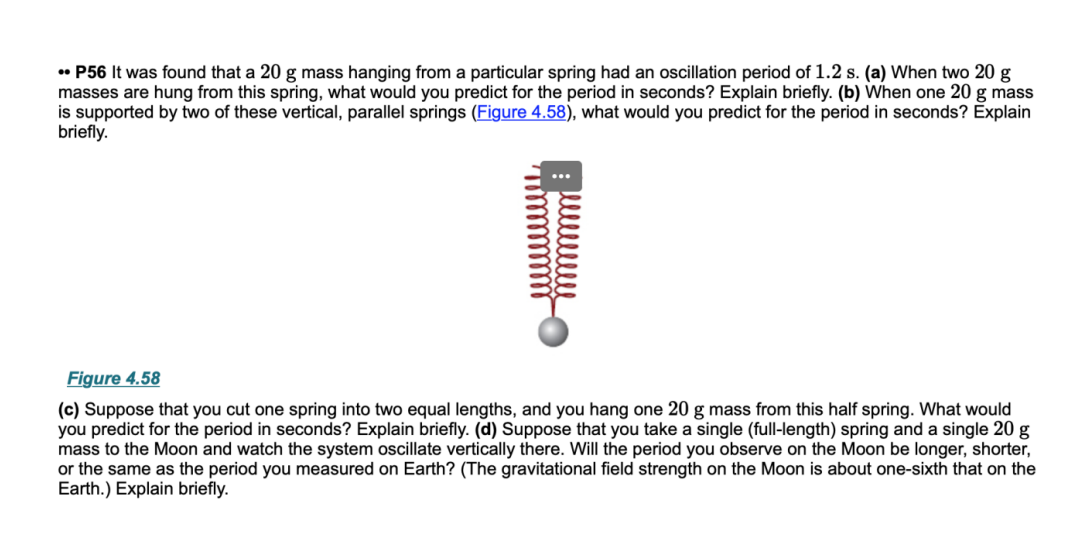• P56 It was found that a 20 g mass hanging from a particular spring had an oscillation period of 1.2 s. (a) When two 20 g masses are hung from this spring, what would you predict for the period in seconds? Explain briefly. (b) When one 20 g mass is supported by two of these vertical, parallel springs (Figure 4.58), what would you predict for the period in seconds? Explain briefly. Figure 4.58 (c) Suppose that you cut one spring into two equal lengths, and you hang one 20 g mass from this half spring. What would you predict for the period in seconds? Explain briefly. (d) Suppose that you take a single (full-length) spring and a single 20 g
• P56 It was found that a 20 g mass hanging from a particular spring had an oscillation period of 1.2 s. (a) When two 20 g masses are hung from this spring, what would you predict for the period in seconds? Explain briefly. (b) When one 20 g mass is supported by two of these vertical, parallel springs (Figure 4.58), what would you predict for the period in seconds? Explain briefly. Figure 4.58 (c) Suppose that you cut one spring into two equal lengths, and you hang one 20 g mass from this half spring. What would you predict for the period in seconds? Explain briefly. (d) Suppose that you take a single (full-length) spring and a single 20 g
Principles of Physics: A Calculus-Based Text
5th Edition
ISBN:9781133104261
Author:Raymond A. Serway, John W. Jewett
Publisher:Raymond A. Serway, John W. Jewett
Chapter12: Oscillatory Motion
Section: Chapter Questions
Problem 58P
Related questions
Question
Hello, I need help with this question.

Transcribed Image Text:• P56 It was found that a 20 g mass hanging from a particular spring had an oscillation period of 1.2 s. (a) When two 20 g
masses are hung from this spring, what would you predict for the period in seconds? Explain briefly. (b) When one 20 g mass
is supported by two of these vertical, parallel springs (Figure 4.58), what would you predict for the period in seconds? Explain
briefly.
Figure 4.58
(c) Suppose that you cut one spring into two equal lengths, and you hang one 20 g mass from this half spring. What would
you predict for the period in seconds? Explain briefly. (d) Suppose that you take a single (full-length) spring and a single 20 g
mass to the Moon and watch the system oscillate vertically there. Will the period you observe on the Moon be longer, shorter,
or the same as the period you measured on Earth? (The gravitational field strength on the Moon is about one-sixth that on the
Earth.) Explain briefly.
Expert Solution
This question has been solved!
Explore an expertly crafted, step-by-step solution for a thorough understanding of key concepts.
This is a popular solution!
Trending now
This is a popular solution!
Step by step
Solved in 5 steps with 4 images

Recommended textbooks for you

Principles of Physics: A Calculus-Based Text
Physics
ISBN:
9781133104261
Author:
Raymond A. Serway, John W. Jewett
Publisher:
Cengage Learning

Physics for Scientists and Engineers
Physics
ISBN:
9781337553278
Author:
Raymond A. Serway, John W. Jewett
Publisher:
Cengage Learning

Physics for Scientists and Engineers with Modern …
Physics
ISBN:
9781337553292
Author:
Raymond A. Serway, John W. Jewett
Publisher:
Cengage Learning

Principles of Physics: A Calculus-Based Text
Physics
ISBN:
9781133104261
Author:
Raymond A. Serway, John W. Jewett
Publisher:
Cengage Learning

Physics for Scientists and Engineers
Physics
ISBN:
9781337553278
Author:
Raymond A. Serway, John W. Jewett
Publisher:
Cengage Learning

Physics for Scientists and Engineers with Modern …
Physics
ISBN:
9781337553292
Author:
Raymond A. Serway, John W. Jewett
Publisher:
Cengage Learning

Physics for Scientists and Engineers: Foundations…
Physics
ISBN:
9781133939146
Author:
Katz, Debora M.
Publisher:
Cengage Learning

Classical Dynamics of Particles and Systems
Physics
ISBN:
9780534408961
Author:
Stephen T. Thornton, Jerry B. Marion
Publisher:
Cengage Learning

College Physics
Physics
ISBN:
9781305952300
Author:
Raymond A. Serway, Chris Vuille
Publisher:
Cengage Learning